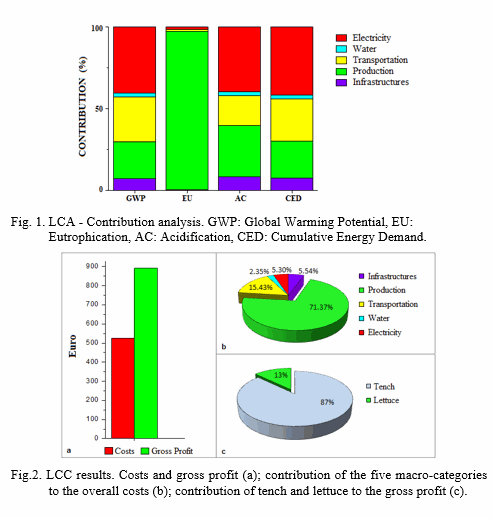LIFE CYCLE ASSESSMENT (LCA) AND LIFE CYCLE COSTING (LCC) APPLIED TO A PILOT AQUAPONIC SYSTEM PRODUCING TENCH AND LETTUCE LOCATED IN THE WWF OASIS OF VALLE AVERTO (VENICE, ITALY)
Introduction
Aquaponics can be defined as the combination of recirculating aquaculture practices and hydroponics. Although this practice is considered sustainable, its environmental burdens and monetary costs are not still deeply investigated (Forchino et al., 2017; Xie and Rosentrater, 2015). The aim of the present study is to apply Life Cycle Assessment (LCA) and Life Cycle Costing (LCC) to a pilot aquaponic system producing tench (Tinca tinca) and lettuce (Lactuca sativa).
Materials and methods
The pilot aquaponic system is located in a 37.5m2 greenhouse and is composed by two sub-units, sharing several common structures and having identical production pathways. Tench are reared in two tanks (Volume=1m3) at an initial biomass of 15kg.m.-3 and fed with commercial extruded pellets. Lettuces are cultivated in 4 grow beds (total surface=5.8m2) at a density of 30 units m-2. A 50W pump is used to create the water flow and bio-mechanical filtration systems guarantees clean water. The functional unit was set as the running time of the system needed to double the tench biomass. System boundaries were set using a cradle-to-gate approach. Input data were divided in five macro-categories: "Electricity", "Water", "Transportation", "Production" and "Infrastructures". For both LCA and LCC calculations were performed using SimaPro® version 8.0.3.14 (PRè, 2014).
Results
According to the contribution analysis obtained with LCA (Figure 1), the highest share in terms of EU is due to production activities and their resulting outputs (i.e. dead fish and lettuce, suspended solid removal). Concerning the other three impact categories, trends appear to be very similar, with "Electricity", "Transportation" and "Production" being the main contributors to impacts. LCC results are reported in Figure 2. "Production" and "Transportation" were found to be the main economic burdens representing 71.4% and 15.4% of the total cost respectively (Figure 2b). Concerning profit, system costs are lower than the gross profit estimated (Figure 2a), and this latter is mainly represented by tench (87%) (Figure 2c).
Discussion and conclusion
The LCA analysis performed underlined strengths and weaknesses of the studied aquaponic pilot system. In particular, both the environmental and economic burdens linked to infrastructure and water consumption appeared low. Water saving represent a plus for aquaponics, if compared with traditional agriculture and it makes this practice suitable also in geographical areas characterized by water scarcity. LCC analysis proved the system to be economically convenient, with most of the profit due to tench sale. By including potential scenarios in the analysis, the combined use of the two methods provides an interesting overview of the whole productive process. Hence, this approach represents a powerful tool for the development of aquaponics at a bigger scale, allowing to highlight hotspots and to detect possible alternative solutions.
References
Forchino A.A., H. Lourguioui, D. Brigolin, and R. Pastres. 2017. Aquaponics and sustainability: the comparison of two different aquaponic techniques using the Life Cycle Assessment (LCA). Aquacult. Engineer 77, 80-88.
PRè, 2014. SimaPro 8. Software. Available at: <http://www.pre.nl>.
Xie K., and K. Rosentrater. 2015. Life cycle assessment (LCA) and Techno-economic analysis (TEA) of tilapia-basil aquaponics. Agricultural and Biosystems Engineering. Conference Proceedings and Presentations 7-2015.
